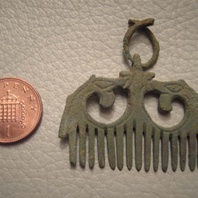
Viking Objects
Comb Pendant (NARC-B3E1B5)
This pendant is unusual for the British isles and has Eastern Scandinavian or Baltic origin. The pendant is decorated with Ringerike-style zoomorphic openwork ornament with a pair of inturning zoomorphic heads. Pendants were a popular dress accessory in Norway and Sweden and sometimes were worn with beads between a pair of oval brooches. In England, pendants did not have the same popularity and there do not seem to be any contemporary Anglo-Saxon pendants.
Read More

Viking Names
Bretby
The first element of Bretby, in the Repton and Gresley Hundred of Derbyshire, comes from either the Old Norse ethnonym Bretar ‘Britons’ or its Old English cognate, Brettas. The second element of the place-name is Old Norse bý ‘a farmstead, a village’. Traditionally, the place-name has been interpreted as referring to Britons who accompanied the Scandinavians in their settlements. However, the exact implications of such a name are not yet fully understood and are the subject of ongoing work by Dr Jayne Carroll of the Institute for Name-Studies, University of Nottingham.
Read More

Viking Names
Asvard
Ásvarðr is an Old Norse compound name from Ás- ‘a god’ and –viðr ‘tree, wood’. There is not much evidence for this name in Old Norse sources. However, there is an Ásvarðr in Norway in the tenth century mentioned in Njáls saga. The name is found as an element in the Danish place-name Asserbo and also found as the first element of Aswarby and Aswardby in Lincolnshire.
Read More
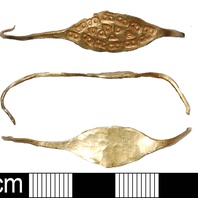
Viking Objects
Gold Finger-Ring (BH-59ECD3)
An Anglo-Scandinavian gold finger-ring decorated with a punched a lozenge-shaped pattern of six triangles with central dots, surrounded by a circumferential band of punched rectangles with two dots. The ends of the wires are hooked, showing that they would originally have been twisted together. Rings like this with knotted ends are typically Scandinavian.
Read More
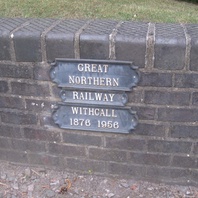
Viking Names
Withcall
Withcall, in the Louth Eske Wapentake of Lincolnshire, is a Scandinavian compound from Old Norse viðr ‘a wood; or a tree, a tree-trunk’ and Old Norse kjǫlr ‘a keel, a ridge (of hills)’, which is topographically appropriate.
Read More
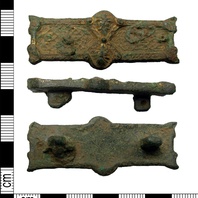
Viking Objects
Gilded Mount (LEIC-127138)
This mount is decorated with rope-like raised decoration, flanked by a plain raised edge. The centre of the mount is decorated with a raised ‘saltaire’ cross. Above and below this cross are semi-circular projections which form the upper part of human face masks which face each other. The remainder of the upper surface is filled with loose ‘chip carved’ interlace. The whole upper surface has patches of gilding, suggesting it originally covered the whole surface. It is possible that it made its way to England prior to Viking incursions but it is equally likely that the Vikings brought this brooch with them as plunder after raiding various areas in Ireland.
Read More
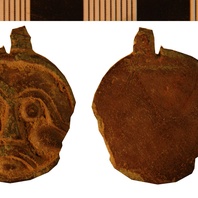
Viking Objects
Copper-Alloy Disc Pendant (NLM-0CA344)
This cast copper-alloy disc pendant has an anthropomorphic design which portrays a facing moustachioed mask. A dark grey coating on front and back may be the degraded remains of a silvered surface. Pendants were a popular dress accessory in Norway and Sweden and sometimes were worn with beads between a pair of oval brooches. For more information on Scandinavian jewellery in England check out our blog: Brooches, Pendants and Pins: Scandinavian Dress Accessories in England.
Read More
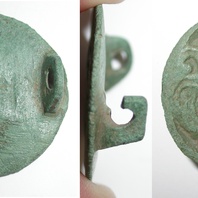
Viking Objects
Borre Style Brooch (DENO-805B20)
This copper-alloy brooch is an example of Kershaw’s East Anglian series and is decorated with interlaced Borre-style designs. For more information on Scandinavian jewellery in England check out our blog: Brooches, Pendants and Pins: Scandinavian Dress Accessories in England.
Read More
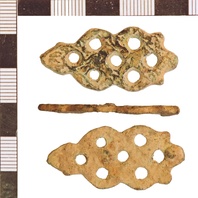
Viking Objects
Anglo-Scandinavian Mount (NLM-491EBD)
This copper-alloy mount is decorated with an openwork plate interlace ornamentation in possible Borre style.
Read More
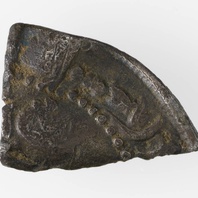
Viking Objects
Abbasid Silver Dirham Fragment (CM_1775_2008)
A silver dirham fragment possibly minted at al-`Abbasiyya. The dirham was a unit of weight used across North Africa, the Middle East, and Persia, with varying values which also referred to the type of coins used in the Middle East during the Viking Age. These coins were extremely prized possessions not only for their silver value but as a way of displaying one’s wealth and vast trade connections. Millions of Arabic dirhams would have been imported throughout the Viking world and are mostly found in hoards.
Read More
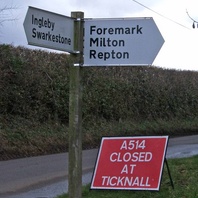
Viking Names
Ingleby
Ingleby, in the Repton and Gresley Hundred of Derbyshire, takes its name from the Old English ethnonym Engle ‘the Angles, later the English’ and Old Norse by ‘a farmstead, a village’. There is also an Ingleby in Lincolnshire (historically Yorkshire). This Ingleby is close to the Viking winter camp at Repton, and the site of a unique Viking Age cremation cemetery. The exact implications of such a name are not yet fully understood and are the subject of ongoing work by Dr Jayne Carroll of the Institute for Name-Studies, University of Nottingham.
